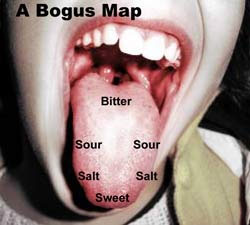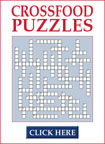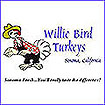The Tongue Map: Tasteless Myth Debunked
By
Christopher Wanjek
LiveScience's Bad Medicine Columnist
The
notion that the tongue is mapped into four areas-sweet,
sour, salty and bitter-is wrong. There are
five basic tastes identified so far, and the entire
tongue can sense all of these tastes more or less
equally.
As
reported in the journal Nature this month, scientists
have identified a protein that detects sour taste
on the tongue. This is a rather important
protein, for it enables us and other mammals to
recognize spoiled or unripe food. The finding
has been hailed as a minor breakthrough in identifying
taste mechanisms, involving years of research
with genetically engineered mice.
This
may sound straightforward but, remarkably, more
is known about
vision
and hearing,
far more complicated senses, than taste.

Maps
like this have been around for ages. But they
are wrong.
LiveScience Bad Graphic. Image: stock.xchange
------------------------------------------------------------------------
Only
in recent years have taste receptors been identified.
One of the first breakthroughs in taste research
came in 1974 with the realization that the tongue
map was essentially a century-old misunderstanding
that no one challenged.
You might know the map: The taste buds for
"sweet" are on the tip of the tongue;
the "salt" taste buds are on either
side of the front of the tongue; "sour"
taste buds are behind this; and "bitter"
taste buds are way in the back. Wineglasses
are said to cater to this arrangement.
The tongue map is easy enough to prove wrong at
home. Place salt on the tip of your tongue.
You'll taste salt. For reasons unknown,
scientists never bothered to dispute this inconvenient
truth.
The map has frustrated many a grade-schooler,
including me, who couldn't get the experiment
right in science class. I failed for insisting
I could taste sugar in the back of my tongue.
In fact, there's more to taste than sweet, sour,
salty and bitter. Most scientists agree
that there's a fifth distinct taste, called umami,
identified by a Japanese scientist named Kikunae
Ikeda in the early 1900s (and ignored by the West
for most of the twentieth century). This
is the taste of glutamate. It is common
in Japanese foods, particularly kombu, a type
of sea vegetable similar to kelp, and in bacon
and monosodium glutamate (MSG), which Ikeda isolated
and patented. There's considerable debate
about the existence of a sixth taste receptor
for fat, too.
The tongue map dates back to research by a German
scientist named D.P. Hanig, published in 1901.
Not familiar with Japanese cuisine, Hanig set
out to measure the relative sensitivity on the
tongue for the four known basic tastes.
Based on the subjective whims of his volunteers,
he concluded that sensitivity to the four tastes
varied around the tongue, with sweet sensations
peaking in the tip, etc. That's all.
In 1942, Edwin Boring, a noted psychology historian
at Harvard University, also apparently unfamiliar
with Japanese cuisine, took Hanig's raw data and
calculated real numbers for the levels of sensitivity.
These numbers merely denoted relative sensitivities,
but they were plotted on a graph in such a way
that other scientists assumed areas of lower sensitivity
were areas of no sensitivity. The modern tongue-map
was born.
In 1974, a scientist named Virginia Collings re-examined
Hanig's work and agreed with his main point:
There were variations in sensitivity to the four
basic tastes around the tongue. (Wineglass
makers rejoiced.) But the variations were
small and insignificant. (Wineglass makers
ignored this part.) Collings found that
all tastes can be detected anywhere there are
taste receptors-around the tongue, on the soft
palate at back roof of the mouth, and even in
the epiglottis, the flap that blocks food from
the windpipe.
Later research has revealed that taste bud seems
to contain 50 to 100 receptors for each taste.
The degree of variation is still debated, but
the kindest way to describe the tongue map is
an oversimplification. Why textbooks continue
to print the tongue map is the real mystery now.
As for the myth that the tongue is the strongest
muscle in the body, this doesn't seem to be true
by any definition of "strength."
The masseter, or jaw muscle, is the strongest
due its mechanical advantage, in which the muscles
attach to the jaw to form a lever. The quadriceps
and gluteus maximus have the highest concentration
of striated muscle fibers, a pure measure of strength.
The heart is the strongest muscle if you measure
strength as continuous activity without fatigue.
The tongue, on the other hand, wears out quickly-at
least with some people.















